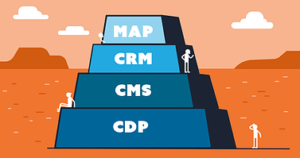Rightsize Your Martech Stack with These 4 Essentials
July 11, 2019As of this writing, there are over 7,000 martech solutions available, compared with only 150 in 2011. Having a big martech stack isn’t that big of a deal anymore. If you’ve got the budget, you can purchase loads of martech to do just about anything. But going on a martech shopping spree will cost you more than money: it may disrupt your focus. Try telling your customers, “we’re too busy buying and implementing martech to focus on you,” and see how that goes. Martech exists to help your B2B marketing team drive improved engagement with customers.
You need a martech stack that provides you with a personalization engine which you can use to drive more relevant content to your customers, something a customer data platform (CDP) helps give you (more on CDPs later).
Rightsizing your stack
The “right” size of your martech stack depends upon your team’s objectives and existing resources. You don’t have to be a minimalist like Marie Kondo to understand that “less can be more.” Start by clearly defining your goals. You don’t want more martech: you want the “right” martech to do the work your marketing team needs done to drive more personalized customer engagement. Understand that the “R” in ROI stands for the return you expect.
Rightsizing your stack is a careful process that requires: (1) analyzing your goals; (2) auditing existing capabilities/resources (including martech); (3) identifying gaps in your capabilities; (4) evaluating what’s available (including martech) to close those gaps; and (5) implementing (and integrating) solutions to enhance your capabilities — which may mean buying the “right” martech to get your personalization engine revving. Defaulting to “just buy more martech” wastes money and potentially gets your team lost in a martech hairball, where goals and martech are so misaligned that you spend more time untangling the mess than driving ROI.
With all that said, there are basic martech tools that every marketing organization will want to have to drive personalization and relevance.
4 Martech stack essentials
- MAP. Back when they became popular in the early 2000s, marketing automation platforms were viewed as “all-inclusive” solutions which marketers could just set up and watch perform every marketing task. Well, MAPs haven’t quite eliminated the need for human marketers. According to MAP vendor Marketo (competitors include Eloqua and HubSpot), MAPs allow B2B marketing teams “to streamline, automate, and measure marketing tasks and workflows, so they can increase operational efficiency and grow revenue faster.”
- CMS. A content management system is an application that allows marketers to create and manage digital content in order to engage their customers. A CMS (WordPress and Drupal are popular vendors) is typically divided into two parts: a content management application (CMA) and a content delivery application (CDA). The CMA is a graphical user interface that allows marketers to easily manage the creation, modification and removal of content from a website. The CDA provides the back-end services that support content management and delivery. If you produce and distribute content, you need a CMS.

- CRM. A customer relationship management system manages your relationships with customers and potential customers so you can drive ROI. A CRM helps everyone in your organization streamline and coordinate customer interactions, and improve KPIs such as customer retention, cross-selling, and profitability per customer. As CRM vendor Salesforce (competitors include Zoho and Insightly) explains, a CRM “gives you a clear overview of your customer” through “a simple, customizable dashboard that can tell you a customer’s previous history, the status of their orders, any outstanding customer service issues, and more.”
- CDP. As the old data science truism goes, “garbage in, garbage out.” A customer data platform takes raw, unfiltered data and enhances its quality and usability in order to provide you an always-on engine to drive personalization and ongoing marketing relevance (and ROI). Unfiltered data goes into the CDP and comes out as a unified and complete view of your customers, as business intelligence, and as actionable insights that enable you to (among other things) personalize engagement with customers, build precise customer profiles and segments, optimize campaign performance, and boost marketing ROI. With a CDP, you can drive marketing relevance in real-time, at every step of the customer journey.
A CDP enables multiple approaches to B2B marketing, from customer segmentation to ABM, and beyond. CDPs with AI/machine learning (AutoML) enable you to identify customer behavioral patterns and apply predictive analytics to boost marketing ROI. You might “get predictive” to tackle customer churn and drive retention by anticipating when and why some customers leave your funnel, taking proactive marketing action to prevent leakage.
Through adopting an ABM strategy, you could identify, profile and segment a select group of your key accounts for your ABM team to target with messaging that better meets their pain points and expectations, thus driving more ROI per key account. You could also identify up-selling and cross-selling opportunities, or craft special offers for specific customer segments whether inside or outside your ABM programs, to drive relevance and profitability. The use cases for a CDP are massive.
Once you have these 4 martech essentials, how you build the rest of your stack depends on your goals, your capability gaps, and your budgets. With a CDP and these other tools, you can build an always-on personalization engine to continually engage your B2B customers and grow your revenues. If you want to learn more about the what, why, and how of CDPs, then visit www.zylotech.com today.


